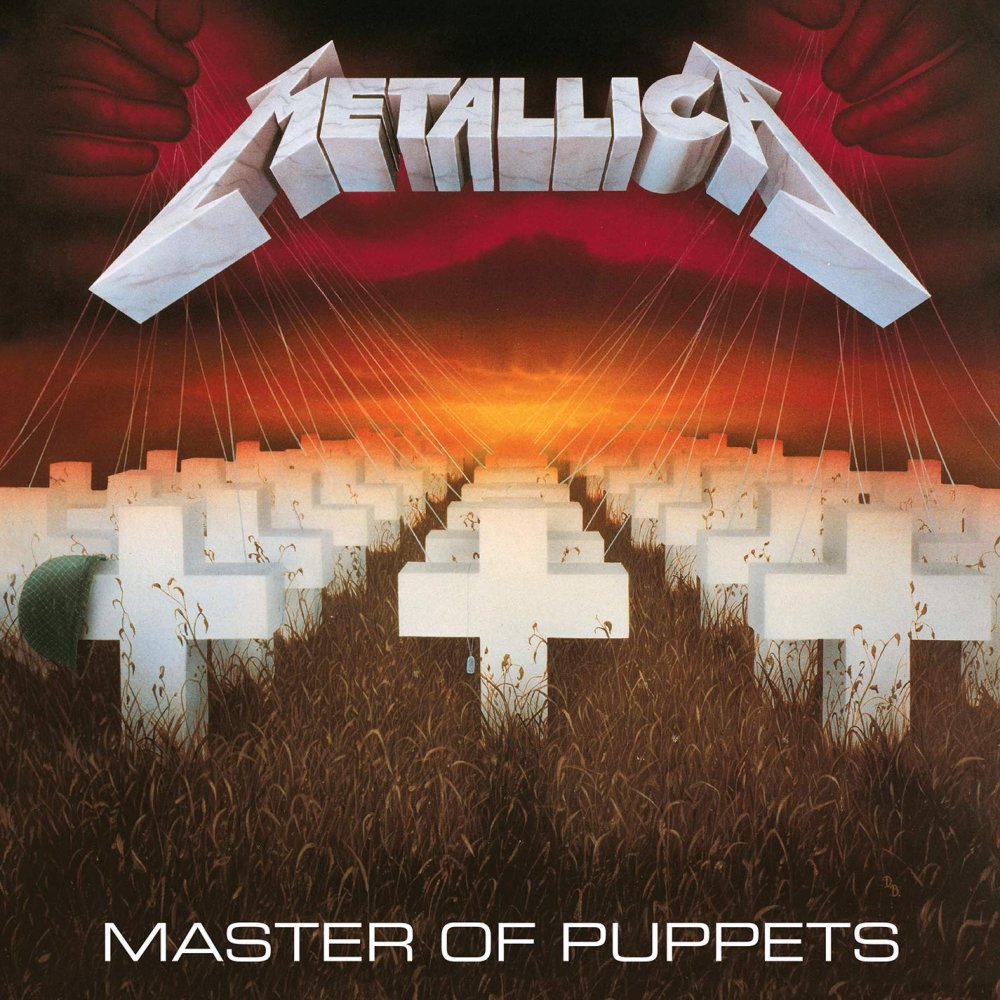
For a lot of fans, their favorite Metallica album is one of the first five. Each one has something to recommend it. Debut album Kill ‘Em All (1983) with its rough, raw, mile-a-minute riffs wears its Motorhead influences on its sweaty denim sleeve. Follow up Ride the Lightning (1984) released just barely a year later shows the band expanding its range from the brute force of “Fight Fire with Fire” to the acoustic sadness of “Fade to Black.” Fourth album …And Justice for All (1988) takes Metallica’s long, complex songwriting to its endpoint as they dealt with their grief—did they ever really deal with it?—over bassist Cliff Burton’s sudden death. As divisive as it was commercially successful, Metallica (1991) set the band’s new direction with pristine production and pruned songs. It’s Master of Puppets that third, middle album, and their last with Burton, that some feel represents Metallica’s peak.
Master of Puppets (1986) certainly has plenty to recommend it for the top spot. Whether it’s the acoustic tripwire leading into the explosive, all-out assault of the appropriately titled “Battery,” the furious thrash of title track “Master of Puppets,” The chugging “The Thing That Should Not Be,” The eeriness of “Welcome Home (Sanitarium),” the angry gallop and thrashout of “Disposable Heroes,” “Leper Messiah’s” condemnation of televangelists, the complexity and many moods of the extended instrumental “Orion,” or the final sledgehammer of “Damage, Inc.,” all of these tracks form one of the most essential documents of thrash metal. Although it was their major label debut, Metallica made it clear there would be no compromises.
The second CD documents the record’s origins and context. Conveniently, Metallica sequences the tracks in the same running order as the finished album, so listeners not only hear the individual tracks, but, collectively, an early version of the whole album from start to finish. I don’t know how much engineering, remixing, and/or equalizing was performed on these tracks, but they sit at the sweet spot between virtually unlistenable demo and finalized track. They don’t depart radically from their studio counterparts, although I did miss “Orion’s” opening volume swells from Burton’s bass, which seem to be replaced with some sort of keyboard. Some versions are shorter, most noticeably “Orion” and “Damage, Inc.,” which are under three minutes combined. Some tracks have vocals and some don’t. “Damage, Inc.” has what sounds like James Hetfield just making some sort of vocal noise to fill in for the vocal/lyrical line. Hetfield’s vocals on “Master of Puppets” sound like the dry husks of dead cornfields flailing in the wind at dusk. We get some glimpses into not just the writing and building up of the record but some alternate ways final tracks could have sounded. These are rough and ragged, of course, especially in the higher frequencies, and have some sharp and flat notes but are a great listen, though they don’t replace any of the finalized versions for me.
The last three tracks on CD two are in-progress versions of “The Money Will Roll Right In” and “The Prince,” and a nineteen-and-a-half-minute interview with Burton backstage shortly before a show in Albuquerque, New Mexico on May 13, 1986 that is part shoot-the-shit about beer and facial hair and part general questions about more serious matters such as Master of Puppets, equipment, lyrics, recording locations, and being on the Elektra label. Burton does not talk to excess but he does converse. Among other interesting tidbits, we learn that he has been listening to “a lot of R.E.M.” This is significant because some fans feel that Metallica would never happened if Burton were still around. The truth is that no one knows what would have happened. Perhaps Burton would have put his foot down. Maybe he would have grudgingly and reluctantly gone along with or even contributed to the more commercial aesthetic of Metallica. Maybe they would have made the change earlier on Justice, though I doubt it. Maybe they would have changed in some other major way: broken up, skipped Load and Reload and returned to their thrashier sound earlier, or ended up with a different bass player because Burton departed the band anyway due to, say, musical differences. Who knows? However, this sort of information about Burton’s then-current listening tastes along with evidence like his last interview in which he speculates that eventually Metallica will write softer music supports the possibility that Burton would have been okay with Metallica (Metallica had already been dabbling with this to some extent with, for example, the chorus of “Escape” from Ride the Lightning). A prophetic moment comes in the interview when Burton defends the album against charges that certain songs aren’t thrashing enough. The idea that Master of Puppets (Master of Puppets?!) might be too light in places is funny from the vantage point of history and the Metallica/Load/Reload trio of albums. With occasional comments and interjections/interruptions from other members such as Hetfield and Lars Ulrich, random movements and noises such as bottles clanking around, and the constant backdrop of music playing close by, the interview creates an immersive experience that really captures the moment and its vibe.
Disc three contains various live performances from the Damage, Inc. Tour. Among the performances is a fan recording of “Fade to Black” from Burton’s last show. It’s the bootleg quality we would expect, but it documents a pivotal night in Metallica’s history. Though the bulk of the song are from recordings with Burton, Metallica remember replacement bassist Jason Newsted’s time with the band via “Seek & Destroy” and “Welcome Home Sanitarium” from Newsted’s live debut with Metallica. Other tracks with Newsted include “Ride the Lightning” and “The Four Horsemen.”
If you’re looking for surprises such as vastly different rearrangements of these songs or guest appearances from Ozzy Osborne whom Metallica toured with, those are not to be found here. What fans get instead are faithful, sturdy, and totally worthy performances of these tracks that give you a realistic representation of what Metallica sounded like live at this time. Some tracks include pre-song banter. So, for example, “For Whom the Bell Tolls” included Hetfield’s explanation of his skateboarding injury and the temporary addition of roadie John Marshall—who later joined Metal Church—as a fill-in on rhythm guitar for the injured Hetfield.
The songs are a mix-and-match from concerts Metallica played on April 21, 1986 (East Rutherford, New Jersey), May 25, 1986 (Chicago, Illinois), August 3, 1986 (Hampton, Virginia), September 26, 1986 (Stockholm, Sweden), November 8, 1986 (Reseda, California), and January 25, 1987 (Essen, West Germany). If you want more, the deluxe box set includes the full versions of each of these concerts. If we examine the liner notes, we see that the performances are not in chronological order and are not grouped by individual concert. For example, songs with Newsted come both before and after songs with Burton and songs from the Aragon Ballroom in Chicago occupy spots 6-8, 11, and 14. My theory is that the track order is meant to reproduce an average setlist from the Damage Inc. Tour. The setlist from the U.S. shows with Cliff Burton is not an exact match, but it comes pretty close. Choosing from multiple shows gives us a fuller sense of what the overall tour sounded like. I haven’t compared the individual tracks from the 3-CD package to the versions from the other concerts, so I can’t render an opinion on which versions are the best—that sort of thing can be highly subjective, anyway—but it’s possible Metallica choose what they think are the best or most significant versions of each song for the third CD.
The package is put together well with lots of color photos and a big booklet. My main issue is that lack of explanatory notes, which give the who/what/where/when of songs, but no reflection or background. Perhaps the assumption is that the hardcores will already know things such as the aforementioned significance of dates that indicate the last/first shows of band members. There is an $8 offer—seems to be expired—for the 108-page book that comes with the deluxe boxset and the 276-page hardcover book about the album is available on Metallica’s website for $40. However, since the CD set is a compression of that larger boxset, why not also include a few pages that sample the most essential notes and remembrances? Still, this is a very fan-friendly, budget-friendly set that is hard to find major fault with. As Burton says in his interview, “You can never satisfy everyone.”
This is a required entry in your metal collection, and the expanded version is good enough that it warrants upgrading even if you already have the record. Even Uncle Sam has a copy. Though not necessarily an authority or last word on metal, the United States Library of Congress deemed it important enough for preservation in the National Recording Registry. As of this writing, Master of Puppets is the only metal album in the Registry.
TRACKLIST
Disc 1: Master of Puppets Remastered
Battery
Master of Puppets
The Thing That Should Not Be
Welcome Home (Sanitarium)
Disposable Heroes
Leper Messiah
Orion
Damage, Inc.
Disc 2: Riffs, Demos, Rough Mixes & Interviews
Battery (Early June 1985 Demo)
Master of Puppets (Late June 1985 Demo)
The Thing That Should Not Be (September 1985 Drum Room Demo)
Welcome Home (Sanitarium) (Late June 1985 Demo)
Disposable Heroes (May 1985, Writing in Progress II)
Leper Messiah (1985, from James’ Riff Tapes II)
Orion (November 1985, Work in Progress Rough Mix)
Damage, Inc. (1985, from James’ Riff Tapes)
The Money Will Roll Right In (Work in Progress Rough Mix)
The Prince (Work in Progress Rough Mix)
Metal Madness Magazine Interview with Cliff
Disc 3: Live From the Damage, Inc. Tour
Battery
Master of Puppets
For Whom the Bell Tolls
Ride the Lightning
Welcome Home (Sanitarium)
The Thing That Should Not Be
(Anesthesia) – Pulling Teeth
Damage, Inc.
Fade to Black
Seek & Destroy
Creeping Death
The Four Horsemen
Am I Evil?
Whiplash



